
How can I help my child with severe autism?
Severe autism can pose significant challenges, but medications and therapies can help
Autism spectrum disorder (ASD) is a neurodevelopmental condition that impacts brain development, resulting in problems with communication, difficulty in social situations, differences in sensory processing, and a tendency to repeat patterns of behavior. For children and adolescents with severe autism, the symptoms can be debilitating, especially when they co-occur with other medical conditions.
Here, we offer an overview of severe autism, outlining symptoms, commonly co-occurring conditions, and effective interventions.
The 3 functional levels of autism
The Diagnostic and Statistical Manual of Mental Disorders, 5th Edition (DSM-5), identifies three levels of severity among autistic patients. These categories assist clinicians and caregivers in determining the degree of support necessary to help autistic people reach their full potential.
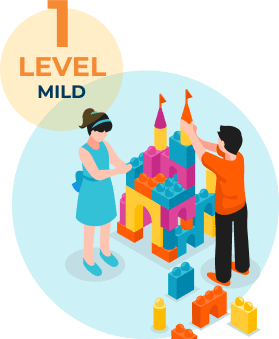
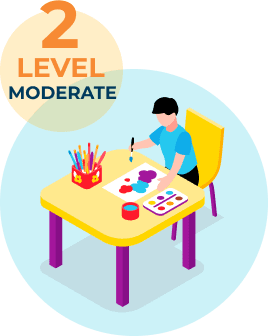
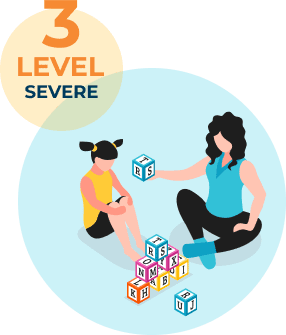
Requiring Support
Requiring Substantial Support
Requiring Very Substantial Support
- Difficulty understanding social cues
- Trouble engaging in reciprocal conversation
- Inflexibility, such as difficulty switching between tasks, staying organized, and planning
- Some difficulty controlling repetitive behaviors
- Challenges with verbal and nonverbal communication
- Reduced or unusual responses to social cues
- More pronounced inflexibility and difficulty with routine
- Repetitive behaviors occur more frequently and are more apparent to casual observers
- Extreme difficulty with social interaction
- Severe speech deficits, ranging from limited vocabulary to completely nonverbal communication
- Pronounced inflexibility and restrictive or repetitive behaviors that interfere with daily life

Requiring Support
- Difficulty understanding social cues
- Trouble engaging in reciprocal conversation
- Inflexibility, such as difficulty switching between tasks, staying organized, and planning
- Some difficulty controlling repetitive behaviors

Requiring Substantial Support
- Challenges with verbal and nonverbal communication
- Reduced or unusual responses to social cues
- More pronounced inflexibility and difficulty with routine
- Repetitive behaviors occur more frequently and are more apparent to casual observers

Requiring Very Substantial Support
- Extreme difficulty with social interaction
- Severe speech deficits, ranging from limited vocabulary to completely nonverbal communication
- Pronounced inflexibility and restrictive or repetitive behaviors that interfere with daily life
Let's take a closer look at the symptoms of severe autism
Let's take a closer look at the symptoms of severe autism
Severe or level 3 autism presents in a variety of ways, and no two patients are exactly alike. Broadly speaking, people with level 3 autism require more extensive therapy, pharmacological intervention, and ongoing support.
Common symptoms include:
Severe communication challenges
Patients may be nonverbal or have extremely limited vocabularies. They may rely on alternative forms of communication, such as picture exchange systems or electronic devices.
more likely to report feeling socially isolated than neurotypical people1
Significant social challenges
Those with level 3 autism often find it extremely difficult to initiate and sustain social interactions. They may show very limited interest in social activities and have trouble understanding social cues.
Repetitive behaviors
Engaging in repetitive behaviors, such as hand-flapping, rocking, or repeating words or phrases (echolalia), is common. These behaviors may be more pronounced and difficult to redirect than they are for those at other levels of the spectrum.
Restricted interests
They may have highly specific and narrow interests and become intensely focused or fixated on them.
Sensory sensitivities
Extreme sensitivity to sensory input, such as sounds, lights, and textures, or an unusual lack of sensitivity, is common among those with level 3 autism. The propensity for sensory overload and distress can be debilitating in everyday life.
Behavioral issues
Many children and adults with ASD also experience behavioral challenges, such as aggression, self-injury, and severe tantrums. Such behavioral issues often arise from difficulty communicating and self-regulating.
of children with ASD have IQs of 70 or lower
Cognitive challenges
Roughly 70% of people with ASD also have some level of intellectual disability, including learning disabilities and low IQ.2
Dependency
Due to the severity of their symptoms, people with level 3 autism typically require substantial support in daily living and may need constant supervision.
of people with autism have at least one co-occurring condition4
Medical conditions that commonly co-occur with autism
Navigating life with severe autism is challenging enough on its own. When patients also have complex medical conditions, finding care and ongoing treatment can become even more difficult. For these individuals, it’s crucial to find an interdisciplinary medical team that can provide comprehensive care.
Some of the most common medical conditions that
co-occur with autism include:
Epilepsy
Seizure disorders are more prevalent among people with autism than in the general population. The risk of epilepsy is higher in those with intellectual disability and those with severe language impairment.
Gastrointestinal (GI) disorders
Many people with autism experience gastrointestinal issues such as constipation, diarrhea, abdominal pain, and gastroesophageal reflux disease (GERD).
of children and adolescents with ASD suffer from sleep problems5
Sleep disorders
Sleep problems, including difficulty falling asleep, staying asleep, or irregular sleep patterns, are common in people with ASD.
Attention-deficit/hyperactivity disorder (ADHD)
Symptoms of inattention, hyperactivity, and impulsivity are often seen in people with autism.
Anxiety disorders
Anxiety is a common co-occurring condition in people with autism, including generalized anxiety disorder, social anxiety, and specific phobias.
Motor disorders
Motor difficulties, including poor coordination, motor planning issues, and hypotonia (low muscle tone), are common among ASD patients.
Feeding issues and nutritional deficiencies
Selective eating, food aversions, and feeding difficulties are also common, which can sometimes lead to nutritional deficiencies.
Mental and behavioral health conditions
Apart from anxiety, individuals with autism may also experience depression, obsessive-compulsive disorder (OCD) and behavioral dysregulation, among other conditions.
of people with autism have at least one
co-occurring condition4
Alleviating the challenges of severe autism with medication and therapy
While there are no medications specifically designed to treat the core symptoms of autism, there are several pharmacological and therapeutic interventions that can help manage co-occurring symptoms and improve quality of life.
Medications
Antipsychotics
Medications like risperidone and aripiprazole are FDA-approved for treating irritability and aggression in children with autism. They can help reduce tantrums, self-injurious behavior, and aggression.
Antidepressants
Selective serotonin reuptake inhibitors (SSRIs) may be prescribed to address anxiety, depression, or obsessive-compulsive behaviors.
Stimulants
In some cases, stimulant medications used for ADHD may be prescribed to help with attention and hyperactivity issues.
Antiepileptic drugs
If seizures are present (as they are in about 20 – 30% of individuals with autism), antiepileptic medications may be necessary.
Therapies
Applied behavior analysis (ABA)
ABA is a widely used therapy for autism that focuses on improving specific behaviors, such as social skills, communication, and adaptive learning abilities. It involves breaking down skills into small, manageable steps and reinforcing positive behaviors.
Occupational therapy (OT)
OT helps individuals with autism develop the skills needed for daily living and independence, such as dressing, eating, and fine motor skills.
Speech and language therapy
This therapy focuses on improving communication skills, including speech, nonverbal communication, and social use of language.
Physical therapy (PT)
PT can help improve motor skills, balance, and coordination in individuals with autism who have motor delays or difficulties.
Sensory integration therapy
Since many individuals with autism have sensory sensitivities, this therapy aims to help them better process and respond to sensory information.
Social skills training
Group or individual therapy can help people with autism develop social skills and better understand social cues and norms.
Cognitive behavioral therapy (CBT)
For older children and adults with autism, CBT can be helpful in addressing anxiety, depression, and other mental health issues.
It’s important to note that the effectiveness of these treatments can vary from person to person. An interdisciplinary approach involving clinicians, therapists, and educators is often necessary to address the diverse needs of individuals with severe autism.
Helping children and adolescents with autism find a new path forward
In Nexus’ New Directions Program, we help patients with autism and other neurodevelopmental disorders develop the tools they need to live more comfortable, fulfilling lives.
Program Features
- Individualized plan addressing developmental delays, including communication, sensory processing, social interaction, interest/item/activity fixation, and repetitive behavior patterns
- Therapeutic activities to develop, maintain, and build upon foundational skills led by physical, occupational, and speech therapists
- Curriculum designed to develop interests, self-confidence, knowledge, and experiences they would otherwise not have access to
- Curriculum supported by best practices, including milieu therapy and naturalistic teaching
- Academic and cognitive concepts integrated into weekly activities to increase exposure
- Pragmatics and social/emotional learning skills developed
- Music, art, and animal assistance therapy to encourage attention, participation, self-awareness, and coping skill development
Meet our Champions
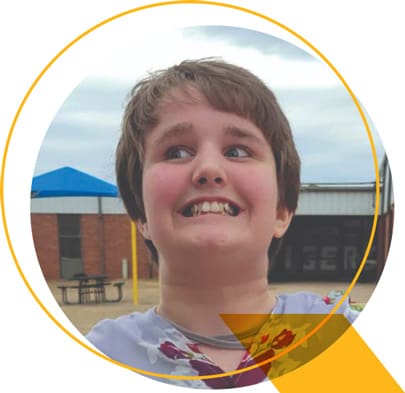
“She developed the ability to self-regulate during high-stress situations. We are so proud of all her progress and the obstacles she conquered.”
— Jessica Cardenas, Behavioral Specialist
Assistant Program Manager
“I never would have thought that this could be my boy. I look back now at videos of him before Nexus, and it’s hard to believe that was him. He’s not the same kiddo. He got so independent.”
— Alicia Hasten, Brody’s mother
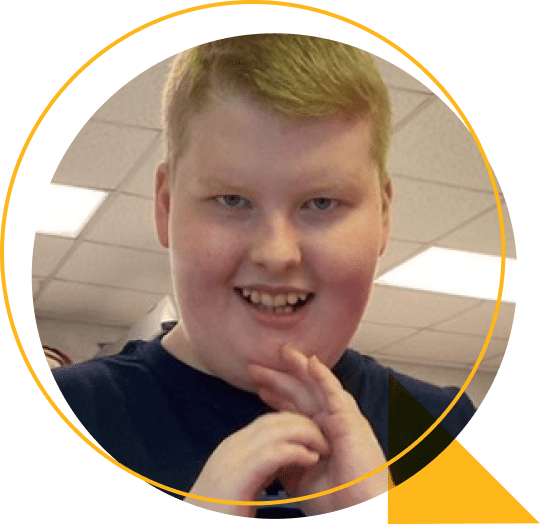
Sources:
- Loneliness and Autism: The Invisible Issue | Psychology Chartered
- Prevalence and Characteristics of Autism Spectrum Disorder Among Children Aged 8 Years | Centers for Disease Control and Prevention
- Intellectual disability and autism spectrum disorders: causal genes and molecular mechanisms | Neuroscience and Biobehavioral Reviews
- Comorbidities in autism spectrum disorder and their etiologies | Translational Psychiatry
- The relationship between autism spectrum disorder and sleep | Sleep Science
